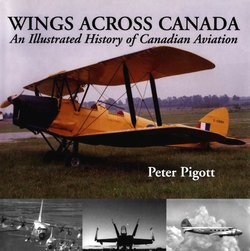Читать книгу Wings Across Canada - Peter Pigott - Страница 7
На сайте Литреса книга снята с продажи.
ОглавлениеCourtesy of the Department of National Defence
Avro 504K
AVRO 504K
The central landing skid, the wing tip hoops, and the hundreds of bracing wires made for an unattractive aircraft. The rotary engine’s gyroscopic force would kill many student pilots. But the Avro 504, especially the K version, was built in great numbers, enough to continue on for a decade after the Treaty of Versailles was signed, to be used as the basic trainer of the RAF, and to become the preferred aircraft of barnstormers in the 1920s.
The Royal Flying Corps initially ordered the 504 as a training and reconnaissance aircraft, but in 1914, they pressed it into service as a bomber in the famous air raid on the airship sheds at Friedrichshafen. The idea of the 504 was to prepare the novice pilot to fly the more pernicious fighter aircraft of that day, like the Sopwith Camel and the Pup — both entirely unforgiving machines. The Avro 504’s greatest advocate was Colonel Robert Smith-Barry, who had long complained that the high casualty rate among inexperienced pilots at the front was the result of the poor training they had received at home. As the new commanding officer at the School for Special Flying in Gosport, Hampshire in 1917, Smith-Barry ordered several Avro 504s, one of which was flown by the first Canadian air ace, Duncan Bell-Irving. In a letter to the family in Vancouver, Bell-Irving would write of the Avro: “I’m here instructing on what is quite the most perfect two seater aeroplane made. AVRO with its 100 hp Le Rhone rotary engine. They’re quite out of date as regards to war but quite the most perfect thing to fly and teach people on.”
There really wasn’t much in the way of controls for the trainee pilot; the four basic instruments were the airspeed indicator, the altimeter, the inclinometer, and the engine speed indicator. On his left, the magneto switch and the fuel tank selection control stood out, as did the control column in the centre and the comparatively large compass that was positioned beneath the dashboard. Takeoff and landing were the most difficult to master, so the instructors kept these for the trainee to learn at the very last. He had no real control over it — it was either on or off. To land the aircraft, the petrol supply was turned off and then turned on again when the wheels were firmly on the ground, the fuel lever adjusted until the engine fired in short bursts for taxiing. If the mixture was too rich when the pilot was in the air, the engine lost power, and all the pilot could do was close the fuel lever off and look for a suitable field to land in. With its lightweight design, the Avro was sensitive to even a slight breeze, and the pilot had to land directly into the wind — probably the last thing on the poor pilot’s mind at the time. The 504’s tandem cockpit, with the instructor in the rear, where he could watch the poor student, was equipped with the latest means of communication, the Gosport tube, invented by Smith-Barry, which could be plugged into the pupil’s helmet. Before its use, instructors communicated by passing notes, by yelling, or, as one hapless pilot recalled, by removing the control column and hitting him on the head with it.
Understandably, given the 504’s propensity for spins, the instructors were afraid to give pupils charge of the aircraft. For the scourge of the 504’s pilot was its engine, or various engines: the 110 hp Le Rhone, the 130 hp Clerget, and, most usually, the 110 hp Gnome Monosoupape rotary engine. Avro had designed the basic airframe to accept each. The rotary engine’s gyroscopic force, combined with its weight in the nose, affected the 504’s handling. It caused the nose to rise on left turns and drop with right, which required compensation by the rudder. Such was the gyroscopic effect that left or right turns needed full left rudder, and the poor pilot was always battling the force from the engine’s torque, which took the aircraft sharply to the right. Little was known about spins then, and many a novice pilot was killed by his inability to recover from an unintentional one. But at a time when many aircraft had rotary engines, this was a common ailment, and the Avro 504 handled better than most — notably the famous Sopwith Camel, which shared the same 110 hp Gnome and 110 hp Le Rhone.
